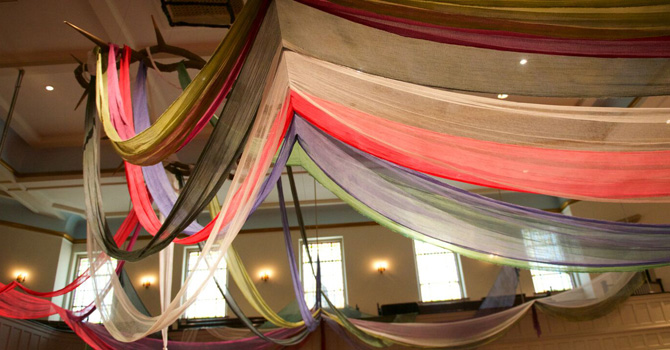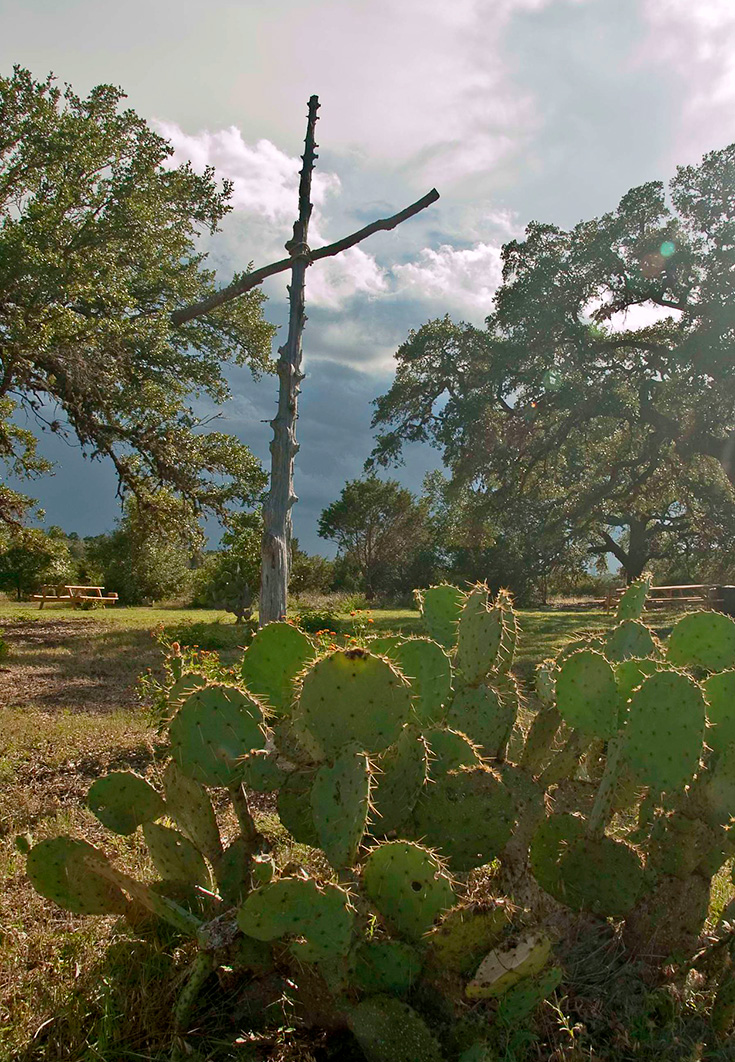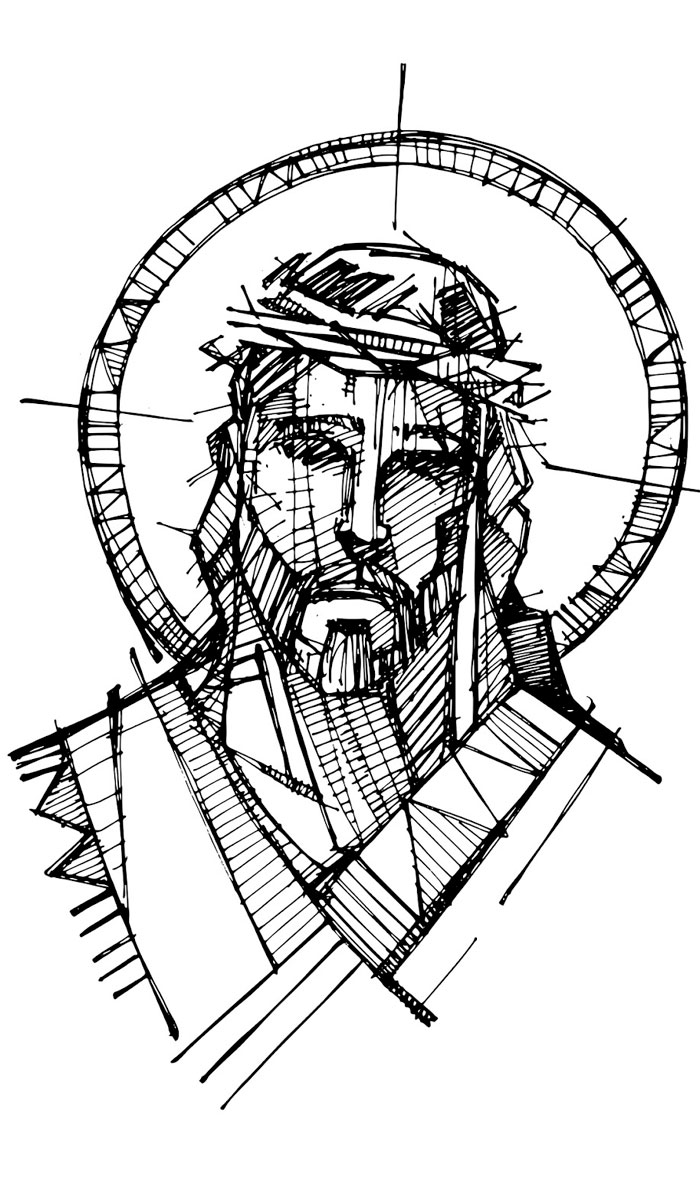With its elegant stained-glass windows and imposing stone columns, Tabernacle Baptist Church swallows the corner of Grove Avenue and Meadow Street in Richmond’s historic Fan District, making it easy for Paul and Lugene Fernald to find.
For months, they’d talked about worshipping at Tabernacle Baptist, ever since Paul heard the Rev. Sterling Severns speak at a seminar about Tabernacle’s approach, which the pastor described as “creative traditional.”
So on Epiphany Sunday 2014, they set out from their shady suburban neighborhood in Midlothian, Virginia. Instead of going to their church, they drove east across the James River into downtown Richmond, in search of something a little different.
The structure of the Tabernacle sanctuary felt fairly conventional, with its rows and rows of weathered pews and its choir loft nestled beneath the Tiffany-style glass depicting Jesus’ baptism in the Jordan.
What about your institution's tradition is worth keeping and where are the places you can begin to innovate?
But Lugene caught her breath when she saw how the congregation had transformed that timeworn space into “a living, breathing thing.”
Brilliant Moravian stars hung suspended from the sanctuary’s ceiling, reminiscent of the bright star that guided the magi to Christ’s birthplace. Bolts of blue fabric cascaded from the rafters like water, recalling Jesus’ baptism. The installation would change over the coming weeks, becoming brighter, as the season that began with a single star in the sky culminated in Jesus’ glorious transfiguration atop a mountain.
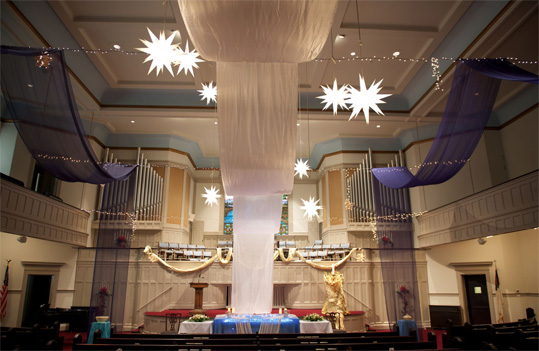
Each season, a musical theme is integrated into the experience as well.
Though her own church had incorporated some creative music and drama into its Easter and Christmas services, it had never celebrated Epiphany.
Lugene Fernald wept during the service -- and every Sunday for the next five or six weeks.
“I felt like I’d been checking in and checking out for too long … and not really becoming engaged in worship. I knew something was missing, but I didn’t know what it was,” she said. “This was something very visually engaging and very purposeful. We could tell that from the beginning, even though we didn’t know what it was all about. Everything was there to support the idea of worship.”
Interested in trying this at your church? Read Severns' tips and watch a video explaining the installation process in depth.
Tabernacle’s pastor, the Rev. Sterling Severns, works with his staff and congregation to create stunning visual installations that are incorporated into traditional worship at the 128-year-old church. Guided by Scripture, he and his staff establish a theme for each liturgical season. They then invite church members to bring that theme to life visually inside the sanctuary. There, using recycled craft materials and a fair amount of duct tape, congregants young and old create vivid installations that evolve with the season.

Though they are eye-catching, and once in a while eyebrow-raising, the installations came about for practical reasons rather than aesthetic ones, Severns said. They were a way to communicate.
Creativity as a common language
When Severns arrived at Tabernacle Baptist in 2004, the church was grieving the loss of its previous pastor, who’d died of a brain tumor, and struggling with the same dramatic decline in membership that plagues many urban churches. Still standing only yards from where it had sprouted in 1887 as a mission school, Tabernacle Baptist Church once boasted the largest Sunday school on the Eastern seaboard.
But the church had watched its pews empty over the previous three decades, as young families moved into the suburbs and its aging membership passed away. Average Sunday attendance numbered around 100 when Severns came to the church, and there were very few children among the congregation.
The church prayed for renewal, which came several years later by way of Burma. Fleeing violence in their home country, a contingent of Burmese refugees had resettled in Richmond and were looking for a place to worship. Tabernacle Baptist Church welcomed the new arrivals, many of whom carried with them Baptist hymnals in their native tongue. The refugees spoke little English. And the church’s existing members spoke no Burmese.
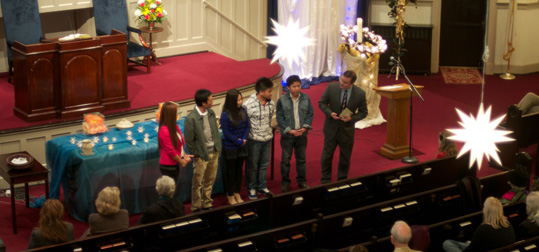
“We had this creative, crazy, beautiful chaos, and we needed to look past the language barrier,” said Severns, who had studied fine-art photography while majoring in religion at Carson-Newman College and had used his camera skills to help pay his way through Baptist Theological Seminary at Richmond. “We basically started to find ways to use visuals to go past that barrier.”
As part of the priesthood of all believers, everyone in the church is a leader and equal participant, Severns said. The refugees, then, weren’t a “project” or a separate subgroup within the church. They were full-fledged members of a congregation that was determined to worship together.
Unlike words on a page, the installations could be understood by all worshippers, regardless of age or native language. And constructing the installations was a way to engage the new arrivals immediately, because everyone was encouraged to participate.
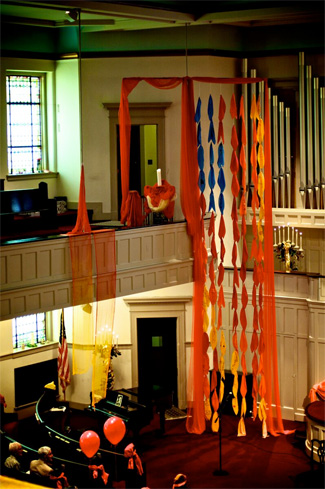
releasing red, yellow and orange balloons.
Judy Fiske, the church’s longtime minister of music and worship, recalls using hand motions to ask a group of Burmese women to sew a tablecloth for an early Pentecost installation. The result was a gorgeous length of red, orange and yellow fabric, embellished with knots of material that resembled flames. Creativity became the common language of worship for Tabernacle’s increasingly diverse congregation.
The first Burmese refugees to join the church occupied one pew. Today, refugees make up about one-fourth of the church’s membership. Though the majority of each service is still in English, most Sundays also include prayers and hymns led by Burmese members in their own dialects.
The visual installations conceived to bridge the language barrier still serve as a way to engage refugees. But they’ve also evolved into teaching aids for others -- those who have come from different religious backgrounds, for example, or even just different Baptist traditions, where Epiphany, Lent and Pentecost aren’t observed.
And since each one is a multigenerational group effort, the installations have helped build community within the church, which now counts between 200 and 250 people in its pews and nursery on Sundays.
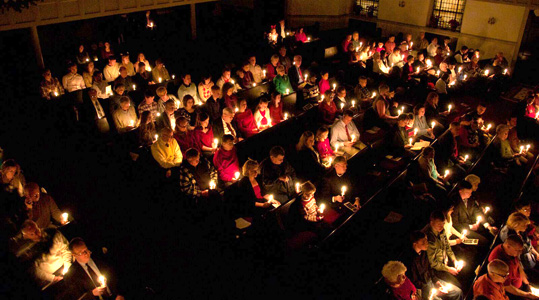
from Burma, who now make up about one-quarter of the congregation.
“It’s very participatory. What you do has meaning. What you do has significance. It’s not just decorating,” said Lugene Fernald, who officially joined Tabernacle around Easter 2014. “You feel like you’re participating in something that’s going to bring meaning to worship. And it does.”
Starting small
The church intentionally started with a relatively small project for Pentecost, which, unlike Christmas and Easter, didn’t already have an established tradition at Tabernacle Baptist. It was the first time many of the church’s members had observed the season.
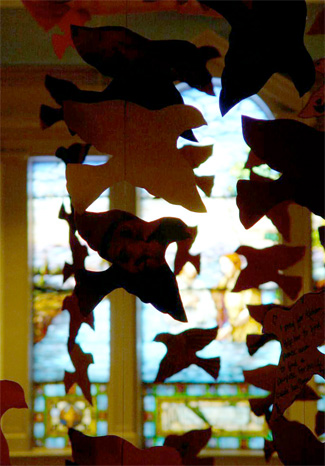
in English and Burmese.
A picture of each church member was printed on a piece of paper that was then cut into the shape of a dove. On the back of each dove, worshippers were urged to write prayers for the person pictured. Some were in English. Others, in Burmese. Many were in the awkward script of children.
Severns asked a congregant who was a welder to fashion three metal rings that could be suspended from the sanctuary’s ceiling. Members then tied the doves to the rings with fishing line from Wal-Mart. Severns figures the whole project cost about $100.
“The doves hovered over the heads of the people. They could look up and see [the pictured] faces, and even if they couldn’t read the prayer, it wasn’t written to them. It was written to God,” he said.
The congregation embraced the concept, and since then, some of its installations have grown more complex.
For Lent one year, members moved the pulpit aside and constructed a sandbox on the chancel, tilting it so worshippers could see inside. Each Sunday, children would come to the front of the sanctuary and place marbles in the sand, gradually creating a path through the metaphorical wilderness. On Good Friday, members stripped the chancel, plucking each marble from the path and dropping it into a bucket with a loud plink that reverberated throughout the sanctuary.
Worshippers have a good deal of freedom in constructing the installations, but the final product is not the result of creativity run amok. Severns describes it as traditional "with a creative twist." Guided by the four-year cycle of the Narrative Lectionary -- and before that, the three-year cycle of the Revised Common Lectionary -- Severns and his staff pore over biblical passages, looking for consistent threads they can weave together into a common theme.
Members of the church are then invited to interpret that theme, relying on a shoestring budget and whatever craft materials they can uncover in the church’s storage room to create a seasonally appropriate installation. Members donate their time, expertise, and occasionally money, and the church also has a small budget of between $200 and $400 annually to support the projects.
The initial construction effort usually takes one night of hard work, but the piece also changes throughout the season. Though the installations don’t run year-round, Severns said, congregants have come to expect one for each major liturgical season.
When participants gather to build the project, Severns first gives them what one member calls “a history lesson,” explaining the context of the season and the relevance of the chosen theme. Members often incorporate images from key scriptural passages, such as doves or fire, as well as seasonal colors.
They also recycle materials from previous installations; a storage area behind the sanctuary overflows with bolts of dyed cheesecloth, king-size sheets and ethnic Burmese fabrics. And Fiske, a Tabernacle staff member for 35 years, keeps a sewing machine under her desk.
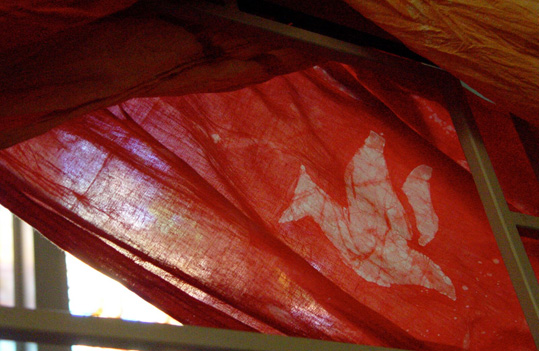
often are part of the installations.
“You have to be sure what you are doing has theological significance and purpose, and if you’re going to put stuff up, there should be a reason why it’s there,” said Fiske, who also comes up with a song of reflection to accompany each season, so there’s continuity from week to week.
New ways to engage with God
The theme for Lent this year was reconciliation. A member who had worked in theater created a massive papier-mâché crown of thorns, while Fiske dyed long swaths of cheesecloth in rainbow colors. One set was soiled, and the idea was that the soiled cloths would flow through one side of the crown of thorns, which was suspended over the sanctuary, while the clean cloths would emerge from the other side and spill down to the floor near the Christ candle, the focal point of each installation.

Lugene Fernald showed up to help, and as Severns and Fiske shared their vision, she imagined that the soiled cloths were chaotic and knotted, while the clean ones were neatly arranged. She suggested the idea to the group, which welcomed it.
“It was a spiderweb of colors from the side where the soiled cloth was. The other side came out in a much more orderly fashion,” said Fernald, recalling the season’s theme. “Reconciliation brings order to our lives, brings us closer to God.”
The installations are integral to the church’s worship experience, and like worship, they’re a community effort, Severns said. The “new” sanctuary, completed in 1923, is hemmed in by streets on two sides and a sprawling network of church offices, classrooms and fellowship space on the others. But within that finite sacred space, worshippers have embraced a variety of ways to engage with God.
Is worship the most important thing your church does? What are the factors that would make you answer “yes” or “no”?
“We’re not trying to create a new church and plop it on an old church,” Severns said. “The space is not malleable, but the church is full of creative thinkers.”
Many of those creative thinkers are quite young. Worship is the most important thing a church does, Severns said, so its children should be deeply involved in every aspect of it. They bring their own special chaos to the process, noted Severns, but they’re always invited to participate, and sometimes asked to lead the way.
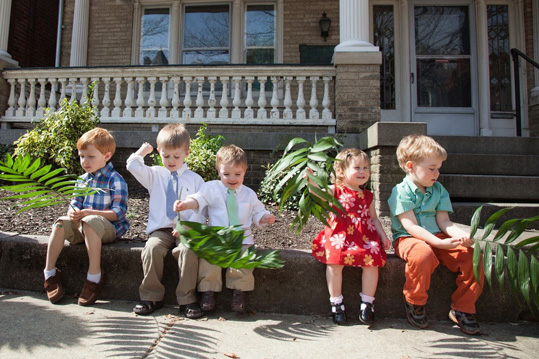
the visual and musical themes.
Just before Pentecost last year, Laura Jones’ son, Jack, who wasn’t quite 11, was asked to teach other church members how to make origami cranes and doves.
On Pentecost Sunday, as the passage from Acts 2 was read, describing the Holy Spirit descending upon the apostles and Jesus’ followers, causing them to speak in tongues, at least a dozen members of the church rose and simultaneously began to read Scripture in other languages, Jones recalled. In the midst of that cacophony, children burst into the sanctuary from every door and released red, yellow and orange helium balloons, each carrying an origami bird upward.
Her children, now 12 and 9, feel like valued members of the congregation because of how regularly they’ve been encouraged to participate in the installations, she said. The projects offer a concrete way for the entire family to connect to worship, Jones said.
“I’m so busy these days that I don’t have the time I used to have to sit and contemplate. To be able to participate in this way helps me mark the changing of the church calendar, the different seasons,” she said. “It’s something, too, for us to talk about as a family. It’s real; it’s tangible. When you participate, it feels like we were there, we were part of the story. We are still part of the story.”
Expecting change
Severns is quick to say that Tabernacle Baptist Church doesn’t consider itself a trendsetter. The initial idea for each installation usually starts with Severns and Fiske, but the two of them say they draw inspiration from other churches, articles in Reformed Worship magazine, Pinterest and other social media sites.
Fiske noticed that an Episcopal church near East Carolina University, where she happened to know the organist, had used about two dozen cinder blocks and candles along with some red fabric for a Taizé service.
At Tabernacle, that morphed into a Pentecost installation featuring 200 cinder blocks, secured by a member who’s a contractor, each with a tea light inside. Every Sunday, members would light the candles and shift the blocks, which symbolized building the church with the Holy Spirit. The installation included an old wooden door that would be moved as well, serving one week as the Communion table and another as a pathway to the baptistry.
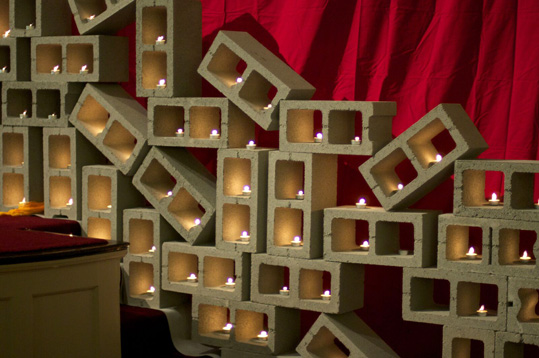
Door imagery is used in many of the church’s installations to symbolize the way the congregation welcomes all in and sends many back out to serve others around the world, Severns said.
The cinder blocks, like the dead crape myrtle branches used one year to convey the wilderness associated with Lent, were not pretty -- and they weren’t intended to be, said Bill Welstead, a member of the church for 50 years. He was skeptical of how they would look in the sanctuary, but in the end, he said, “We just had wonderful worship experiences with cinder blocks.
“It worked. It’s always worked. There’s never been a time when I said, ‘Well, this just falls flat,’” Welstead said. “It’s not routine; it’s not rote. There’s always a message in it that enhances the experience.”
In your congregation, is there is space for aesthetics that are not pleasing?
The installations are never static. Each week, an element is removed, added or altered in some way that reflects the direction of that week’s worship. There’s an air of anticipation each Sunday as worshippers enter the sanctuary and try to track the transformation, Severns said.
“The change isn’t just for the sake of change. It’s more that God is changing us,” said Severns, noting that a member recently shared the following observation: “My assumption,” she said, “is when I walk in the room, something will have changed, and that reminds me that change is expected in me, too.”
Questions to consider
Questions to consider
- The Rev. Sterling Severns describes Tabernacle's approach as traditional worship “with a creative twist.” There is actually only one twist to their worship, but it has a significant impact. What one thing could you do in your institution that would have a significant impact?
- Tabernacle uses visual arts to help overcome the language barrier for 25 percent of their membership. What creative tools does your community use to overcome barriers?
- Severns leads Tabernacle in traditioned innovation by creating new ways to worship in a traditional space. What about your institution's tradition is worth keeping and where are the places you can begin to innovate?
- Severns emphasizes the importance of intergenerational participation in the implementation of the installations. What would happen in your institution if the children burst into a service and released helium balloons?
- Is worship the most important thing your church does? What are the factors that would make you answer “yes” or “no”?
- In the accompanying list of tips, Severns reminds us in No. 4 that the goal is not a pleasant appearance, but one that is immersive and explanatory. In your congregation, is there is space for aesthetics that are not pleasing?

